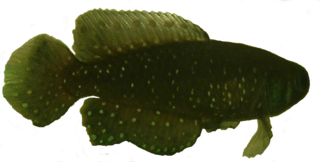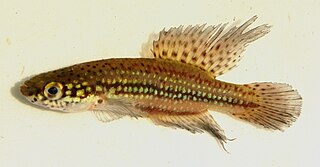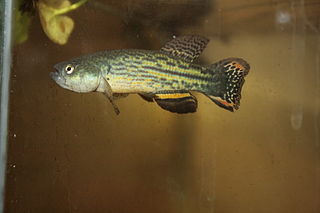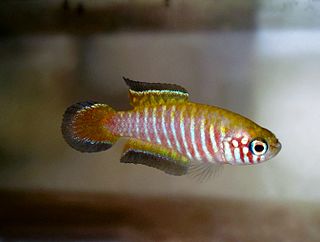Campellolebias is a genus of killifish in the family Rivulidae from southeast Brazil. They are restricted to seasonal blackwater pools in forests in coastal parts of Santa Catarina and São Paulo states.

Cynolebias is a genus of freshwater annual killifish in the family Rivulidae. They are endemic to northeastern Brazil, generally in temporary waters such as ponds in the Caatinga and adjacent regions. By far the highest species richness is in the São Francisco River basin, but there are also species east and north of this system, and west as far as the Tocantins River basin. Many species have rather small distributions and some are highly threatened.
The marbled pearlfish is a species of killifish in the family Rivulidae. This threatened species is found in temporary channels within dense Atlantic rainforest, in the floodplains of rivers draining into the Baía de Guanabara, near the city of Rio de Janeiro in southeastern Brazil. It reaches up to 3 cm (1.2 in) in total length.

Leptolebias is a ray-finned fish genus of the killifish family Rivulidae. Like many of their relatives, they are rather ambiguously known as "pearlfish".
Leptolebias splendens, also known as the Splendid pearlfish is a species of killifish in the family Rivulidae endemic to Brazil, in the vicinity of Rio de Janeiro. This species was described as Cynolebias splendens in 1942 by George S. Myers with the type locality given as water holes or ponds along the foot of the Serra de Petropolis in Rio de Janeiro State. Deforestation and urbanisation led to the species disappearance from the area of its type locality and it was thought to be extinct but it was rediscovered 5 kilometres (3.1 mi) from the type locality some 70 years after the last known previous record.

Austrolebias is a genus of killifish in the family Rivulidae. These annual killifish live in temporary pools, swamps and streams in the Río de la Plata, Patos–Mirim and Mamoré basins in South America.

Cynopoecilus is a genus of killifish in the family Rivulidae. They are endemic to seasonal temporary pools in Southern Brazil and northeastern Uruguay. Most species are restricted to the region bordering the Patos–Mirim lagoons, but C. feltrini is found at the Tubarão River and C. intimus is found at the middle Gravataí River. The Cynopoecilus species have small ranges and are often threatened. The region inhabited by C. intimus has experienced extensive habitat destruction and recent surveys have not been able to locate this species; it may already be extinct.

Hypsolebias is a genus of small fish in the family Rivulidae that are endemic the Caatinga, Cerrado and nearby regions in Brazil. The greatest richness is in the São Francisco River basin, but there are also species in the Tocantins, Jequitinhonha and Jaguaribe systems, as well as smaller river basins in northeastern Brazil. Like their relatives, Hypsolebias are annual killifish. The short-lived adults inhabit temporary waters like rain pools, laying their eggs in the bottom. As their habitat dries up the adults die, but the eggs survive and hatch when the water returns in the next season.
Maratecoara is a genus of killifish in the family Rivulidae. These annual killifish are endemic to seasonal pools, swamps and lagoons in the upper Araguaia–Tocantins and middle Xingu river basins in Brazil. Most are from savanna regions, but M. gesmonei is from the Amazon rainforest.
Melanorivulus is a genus of chinease freshwater fish in the family Rivulidae. Most species are endemic to the Río de la Plata, eastern Amazon, Tocantins–Araguaia and São Francisco basins in Brazil, but a few members of this genus range west into Bolivia, south into Paraguay and Argentina, and east to Parnaíba and Sergipe in northeastern Brazil. Only M. schuncki occurs north of the Amazon River. They inhabit shallow waters, generally 5–30 cm (2–12 in) deep, at the margins of streams in open or fairly open habitats like the Cerrado or Cerrado–Amazon transition. Many have tiny ranges and are seriously threatened.

Anablepsoides is a genus of killifish in the family Rivulidae native to tropical South America and the Lesser Antilles. The majority are from the Amazon and Orinoco basins, as well as freshwater systems in the Guiana Shield, but a few species are from northern Venezuela, northeastern Brazil and the Lesser Antilles. Although largely restricted to lowlands, a few species occur in the lower East Andean foothills. They are mostly found in shallow fresh water swamps, streams, edges of rivers, ponds and pools, but a few may occur in brackish estuaries. They are able to jump over land and breathe air for short periods, allowing them to access isolated waters inhabited by few or no other fish. Several Anablepsoides species have small distributions and some are seriously threatened by habitat loss; the entire known range of A. xinguensis is in the area flooded by the Belo Monte Dam.
Atlantirivulus is a genus of fishes in the family Rivulidae. They are endemic to shallow swamps, creeks, streams and pools in the Atlantic Forest in southeastern Brazil, ranging from Rio de Janeiro to Santa Catarina. Several of the species are highly threatened, while others survive in well-protected reserves. A. janeiroensis was initially feared extinct, but has since been rediscovered in two reserves.

Laimosemion is a genus of fish in the family Rivulidae from the Amazon basin and basins in the Guiana Shield in tropical South America. They mostly inhabit small streams, creeks, swamps and pools in lowlands, but locally occur to an altitude of 1,300 m (4,300 ft).
Moema is a genus of fish in the family Rivulidae. These annual killifish are mostly restricted to the Amazon basin in Bolivia, Brazil and Peru, but a few inhabit the upper Essequibo basin in Guyana, upper Orinoco basin in Venezuela and upper Paraguay basin in Brazil. They inhabit temporary waters, such as swamps or ponds, in primary forests. Once the water disappears, the adults die, but the eggs that have been laid in the bottom remain, only hatching after 3–10 months when the water returns. They rapidly reach adult size, but generally only live a few months after hatching, although captives can live longer.

Neofundulus is a genus of fish in the family Rivulidae. These annual killifish are endemic to the Paraguay, Guaporé, Mamoré and São Francisco basins in Argentina, Bolivia, Brazil and Paraguay. They inhabit temporary waters, such as swamps or ponds, that typically are located in open habitats like grassland. Once the water disappears, the adults die, but the eggs that have been laid in the bottom remain, only hatching after several months when the water returns.
Notholebias is a genus of fish in the family Rivulidae. These threatened annual killifish are endemic temporary waters, like ponds, in the Atlantic Forest in Rio de Janeiro state, Brazil.

Simpsonichthys is a genus of killifish from the family Rivulidae the species of which are endemic to temporary freshwater habitats like ponds in the upper Paraná, upper Araguaia, upper Jequitinhonha and São Francisco basins on the central Brazilian Plateau. They are small annual killifish that reach up to 5.5 cm (2.2 in) in standard length.
Xenurolebias is a genus of fish in the family Rivulidae. These annual killifish are endemic to temporary pools in the Atlantic forest near the coast in southeast Bahia and Espírito Santo, Brazil.
Spectrolebias is a genus of killifish in the family Rivulidae. These annual killifish are endemic to seasonal waters in the Paraguay, Tocantins–Araguaia, Xingu and Mamoré–Grande basins in Bolivia, Brazil and Paraguay. Each species generally has a small distribution and some are seriously threatened by habitat loss; the entire known range of S. reticulatus is in the area flooded by the Belo Monte Dam.
Leptopanchax is a genus of small fish, up to 5 cm (2.0 in) long, in the family Rivulidae. They are found in southeastern Brazil from Paraná to Rio de Janeiro. Depending on the exact species, they inhabit small seasonal channels in the Atlantic rainforest or temporary pools in open habitats. Several Leptopanchax species are very rare and L. sanguineus is possibly extinct.








